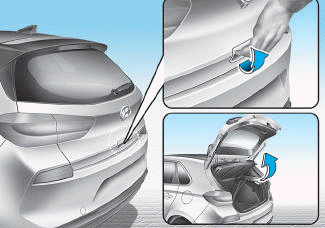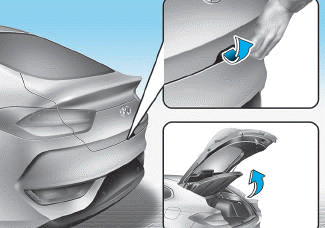Hyundai i-30: Emission control system / Exhaust emission control system
The Exhaust Emission Control System is a highly effective system which controls exhaust emissions whilst maintaining good vehicle performance.
Vehicle modifications
This vehicle should not be modified. Modification of your vehicle could affect its performance, safety or durability and may even violate governmental safety and emissions regulations. In addition, damage or performance problems resulting from any modification may not be covered under warranty.
• If you use unauthorised electronic devices, it may cause the vehicle to operate abnormally, wire damage, battery discharge and fire. For your safety, do not use unauthorised electronic devices.
Engine exhaust gas precautions (carbon monoxide)
• Carbon monoxide can be present with other exhaust fumes.Therefore, if you smell exhaust fumes of any kind inside your vehicle, have it inspected and repaired immediately. If you ever suspect exhaust fumes are coming into your vehicle, drive it only with all the windows fully open. Have your vehicle checked and repaired immediately.
WARNING
Engine exhaust gases contain carbon monoxide (CO). Though colourless and odourless, it is dangerous and could be lethal if inhaled. Follow the instructions following to avoid CO poisoning.
- Do not operate the engine in confined or closed areas (such as garages) any more than what is necessary to move the vehicle in or out of the area.
- When the vehicle is stopped in an open area for more than a short time with the engine running, adjust the ventilation system (as needed) to draw outside air into the vehicle.
- Never sit in a parked or stopped vehicle for any extended time with the engine running.
- When the engine stalls or fails to start, excessive attempts to restart the engine may cause damage to the emission control system.
Operating precautions for catalytic converters
WARNING
- A hot exhaust system can ignite flammable items under your vehicle. Do not park, idle, or drive the vehicle over or near flammable objects, such as dry grass, paper, leaves, etc.
- The exhaust system and catalytic
system are very hot
whilst the engine is running or
immediately after the engine is
turned off. Keep away from the
exhaust system and catalytic
converter as you may get
burned.
Also, do not remove the heat sink around the exhaust system, do not seal the bottom of the vehicle and do not coat the vehicle for corrosion control. It may present a fire risk under certain conditions.
Your vehicle is equipped with a catalytic converter emission control device.
Therefore, the following precautions must be observed:
- Use only UNLEADED FUEL for petrol engines.
- Do not operate the vehicle when there are signs of engine malfunction, such as misfire or a noticeable loss of performance.
- Do not misuse or abuse the engine. Examples of misuse are coasting with the engine off and descending steep grades in gear with the engine off.
- Do not operate the engine at high idle speed for extended periods (5 minutes or more).
- Do not modify or tamper with any part of the engine or emission control system. All inspections and adjustments must be made by a HYUNDAI authorised repairer.
- Avoid driving with a very low fuel level. If you run out of petrol, it could cause the engine to misfire and result in excessive loading of the catalytic converter.
Failure to observe these precautions could result in damage to the catalytic converter and to your vehicle. Additionally, such actions could void your warranties.
Diesel particulate filter (DPF)
The Diesel Particulate Filter (DPF) system removes the soot in the exhaust gas.
The DPF system automatically burns (or oxidizes) the accumulated soot in accordance with driving situations, unlike a disposable air filter.
In other words, the accumulated soot is automatically purged out by the engine control system and by the high exhaust-gas temperature at normal/ high driving speeds.
However, when the vehicle is continually
driven at repeated short distances
or driven at low speed for a long time,
the accumulated soot may not be
automatically removed because of low
exhaust gas temperature. In this case,
the accumulated soot is out of the
detection range, the soot oxidization
process does not occur, and the
Diesel Particulate Filter (DPF) Lamp
( ) Illuminates.
) Illuminates.
The Diesel Particulate Filter (DPF) Lamp stops illuminating, when the driving speed exceeds 37mph (60 km/h), or when the engine rpm is between 1,500 and 2,500 with the gear in the 2nd position or above for approximately 25 minutes.
When the DPF Lamp continuously blinks or the warning message “Check exhaust system” illuminates in the above cases, we recommend that you have the DPF system checked by a HYUNDAI authorised repairer.
When the vehicle is continuously driven with the DPF Lamp flashing for an extended period of time, it may damage the DPF system and lower the fuel economy.
CAUTION
Diesel Fuel (if equipped with DPF)
We recommend you to use only the regulated diesel fuels, when your vehicle is equipped with the DPF system.
When you use other diesel fuels, which are high in sulfurs (above 50 ppm) or that contain unspecified additives, they may damage the DPF system and cause white smoke emissions.
Lean NOx Trap (if equipped)
The Lean NOx Trap (LNT) system removes the nitrogen oxide from the exhaust gas. A smell can occur in the exhaust gas depending on the quality of the fuel, and it can degrade NOx reduction performance. Please use the regulated automotive diesel fuel.
Gasoline (Petrol) Particulate Filter (GPF) (if equipped)
The Gasoline (Petrol) Particulate Filter (GPF) system removes the soot in the exhaust gas.
The GPF system automatically burns (or oxidises) the accumulated soot in accordance with driving situations, unlike a disposable air filter.
In other words, the accumulated soot is automatically purged out by the engine control system and by the high exhaust-gas temperature at normal/ high driving speeds.
However, when the vehicle is continually
driven at repeated short distances
or driven at low speed for a
long time, the accumulated soot may
not be automatically removed
because of low exhaust gas temperature.
In this case, the accumulated
soot is out of the detection range, the
soot oxidization process does not
occur, and the Gasoline (Petrol)
Particulate Filter (GPF) Lamp ( )
Illuminates.
)
Illuminates.
The Gasoline (Petrol) Particulate Filter (GPF) Lamp stops illuminating, when the driving speed exceeds 50 mph (80 km/h) with engine rpm 1,500 ~ 4,000 and the gear in the 3rd position or above for approximately 30 minutes.
When the GPF Lamp continuously blinks or the warning message “Check exhaust system” illuminates in the above cases, we recommend that you have the GPF system checked by a HYUNDAI authorised repairer.
When the vehicle is continuously driven with the GPF Lamp flashing for an extended period of time, it may damage the GPF system and lower the fuel economy.
CAUTION
Gasoline (Petrol) Fuel (if equipped with GPF)
We recommend you to use only the regulated petrol fuels, when your vehicle is equipped with the GPF system.
When you use other petrol fuels which contain unspecified additives, they may damage the GPF system and cause exhaust emission problems.
Lean NOx Trap (if equipped)
The Lean NOx Trap (LNT) system removes the nitrogen oxide from the exhaust gas. A smell can occur in the exhaust gas depending on the quality of the fuel, and it can degrade NOx reduction performance. Please use the regulated automotive diesel fuel.
 Emission control system
Emission control system
The emission control system of your
vehicle is covered by a written limited
warranty. Please see the warranty
information contained in the
Warranty Booklet in your vehicle...
 Selective Catalytic Reduction
Selective Catalytic Reduction
The Selective Catalytic Reduction
(SCR) system is to catalytically convert
NOx to Nitrogen and Water by
using the reduction agent, the urea
solution...
Categories
- Manuals Home
- 3rd Generation i30 Owners Manual
- 3rd Generation i30 Service Manual
- To activate the ISG system
- Tyre pressure monitoring system
- Battery replacement
- New on site
- Most important about car
Tailgate
Opening the tailgate

■ 5 Door, Wagon

■ Fastback
